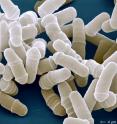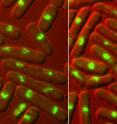New tasks attributed to Aurora proteins in cell division
Related images
(click to enlarge)
When a cell divides, the genetic information in the chromosomes must be passed on error-free to the daughter cells. Researchers at the Friedrich Miescher Laboratory in Tübingen are studying this process using fission yeast as a model organism. In cooperation with researchers at the University of Tübingen, they succeeded in attributing additional tasks to the Aurora enzymes, which were already recognized as important cellular tools for the reliable transmission of genetic information. Because uncontrolled cell division is a feature of tumours, Aurora enzyme inhibitors are already being tested as new cancer treatments, and these new insights from basic research may prove to be of use for this clinical research. Fission yeast (Schizosaccharomyces pombe) is a unicellular fungus and an organism with a comparatively simple composition. Nonetheless, its cellular make-up is the same as that found in more complex organisms, for example humans. Therefore, fission yeast, which has a small genome and can easily be reproduced, lends itself well to the study of basic cell functions. Silke Hauf, Independent Research Group Leader at the Max Planck Society's Friedrich Miescher Laboratory and her colleague André Koch, together with Boris Macek, Director of the Proteome Center at the University of Tübingen and his colleagues Karsten Krug and Stuart Pengelley, carried out in-depth research on cell division in fission yeast.
During cell division, each daughter cell receives a complete copy of the mother cell's genetic information. To this end, the genetic information is bundled in the form of microscopically visible chromosomes. The chromosomes are separated and distributed to the daughter cells with the help of a spindle apparatus. "We have known for some time now that Aurora enzymes play a key role in these processes," says Silke Hauf. "They control the compaction of the chromosomes and regulate their attachment to the spindle apparatus." Like many other regulatory enzymes, Aurora enzymes trigger changes in the cell by attaching phosphate groups to other proteins.
Silke Hauf and Boris Macek combined their respective expertise in cell biology and proteomics to obtain an overview of the range of proteins that are altered by the Aurora enzymes. The researchers used a modern technique based on the labeling of proteins with stable isotopes and their identification using mass spectrometry. "This procedure, which is termed phosphoproteomics, enables us to carry out quantitative analyses on thousands of phosphorylated proteins in a single experiment. We were therefore able to identify dozens of new Aurora substrates in a single study. This process would have taken a very long time using conventional methods," explains Boris Macek. The researchers meticulously compared the phosphorylation events present on proteins of dividing cells in which Aurora enzymes were active with cells in which these enzymes were inhibited. Using this approach, they were able to filter out 42 proteins, whose phosphorylation was dependent on the activity of the Aurora enzymes, among more than a thousand proteins, on which phosphate groups were found. "We found some proteins which we already knew to be altered by Aurora enzymes. A surprising finding, however, was the fact that Aurora also changes proteins which play an important role in the packaging of the DNA and others which play a role in protecting the DNA," reports Silke Hauf. "Overall, Aurora may be responsible for a considerably wider range of tasks in cell division than previously thought," adds André Koch, first author of the study.
Fission yeast is obviously not a human being. Nonetheless, many vital processes proceed in a very similar way in yeast and in human cells. Silke Hauf assumes that the new research findings will also apply to Aurora enzymes in humans. If this turns out to be correct, the results of the study will be relevant for the development of new cancer treatments that aim to attack the uncontrolled cell division of tumours. "Treatment with Aurora enzyme inhibitors, as is currently being tested in clinical trials, could have previously unexpected effects," says the scientist. Further research will be needed to establish whether Aurora inhibitors will prove helpful in blocking the growth of tumours or whether they may cause undesirable side effects.
Source: Max-Planck-Gesellschaft
Other sources
- New tasks attributed to Aurora proteins in cell divisionfrom PhysorgThu, 30 Jun 2011, 16:31:45 UTC
- New tasks attributed to Aurora proteins in cell divisionfrom Science DailyThu, 30 Jun 2011, 15:31:16 UTC

